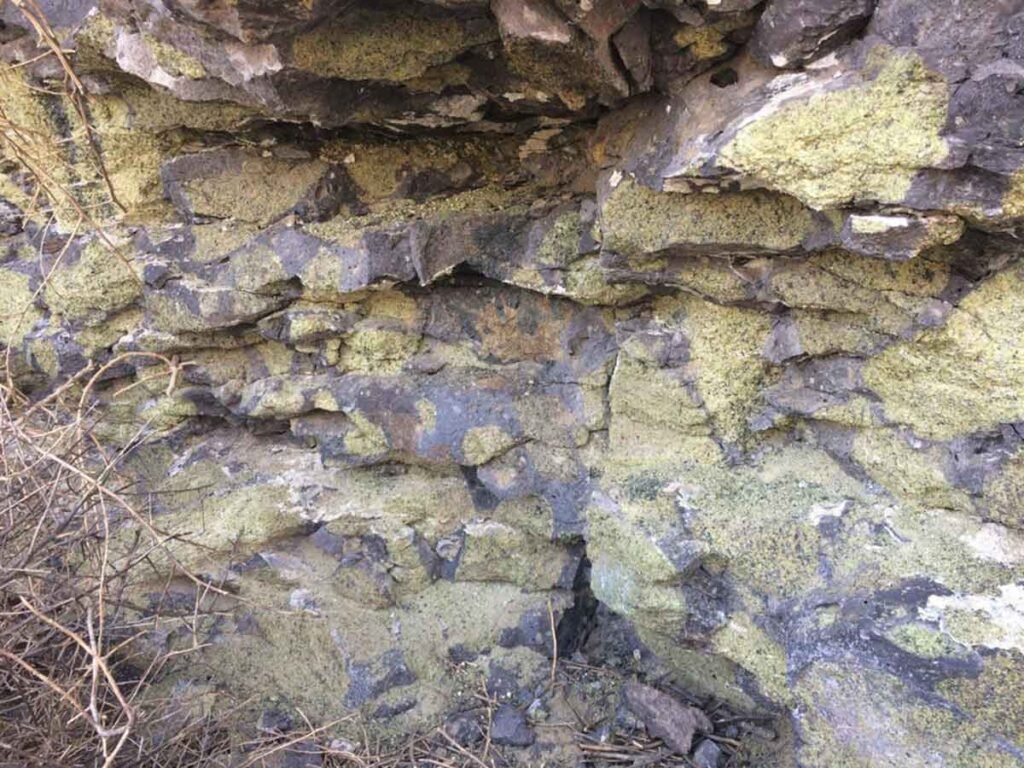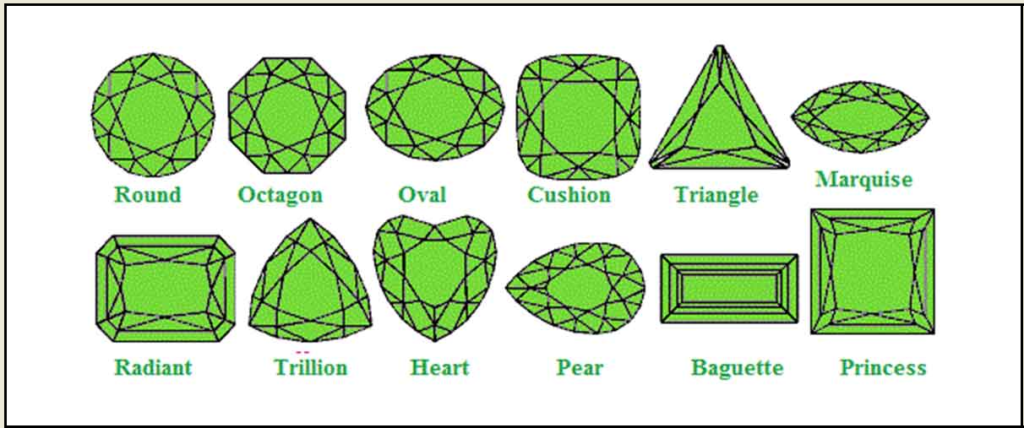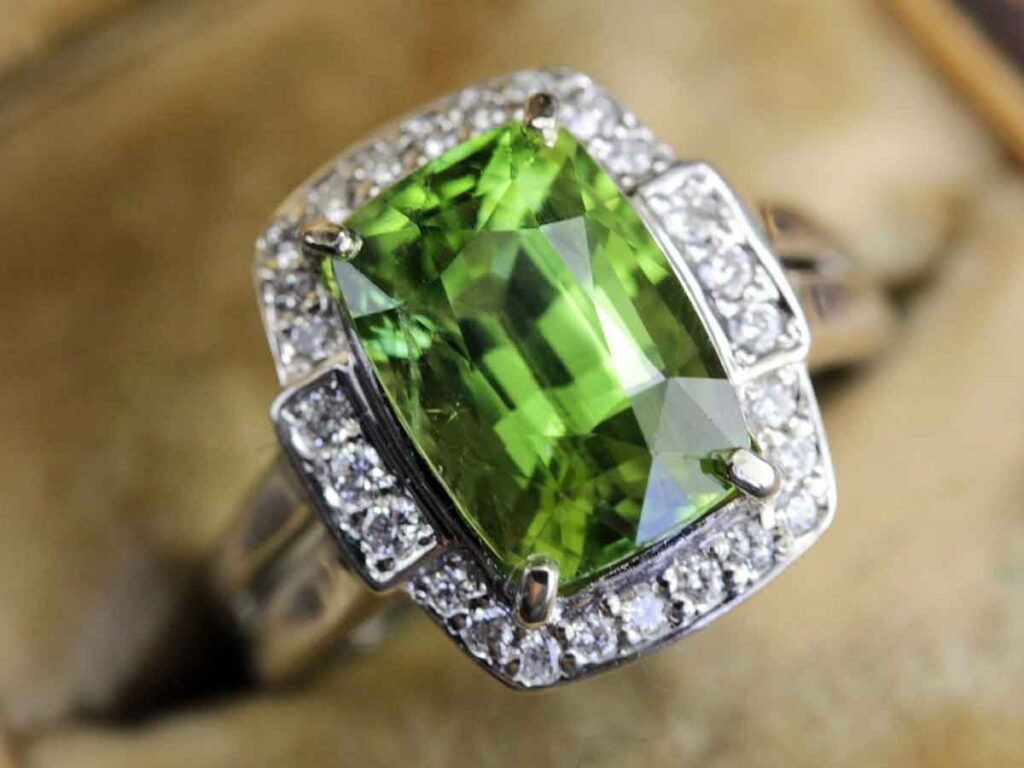If you’ve ever seen a peridot (pronounced pear-a-dot or pear-a-doe) jewelry piece, you can’t help but find it adorable. Its yellowish-green hue sparkles and shimmers at the slightest hint of light. Its translucence seems to invite you to look into it to see its glorious past and mysterious character.
Peridot is an ancient stone. Ancient Egyptians have been using it as early as 1500 B.C. They mined it on an island cloaked with secrecy—the Zebergad Island in the Red Sea. They kept the location a secret from anybody else. When the Egyptian Empire fell, its location got buried in antiquity. It was not until 1906. that the island was rediscovered, albeit, with a new name—St. John’s Island.

Peridot is a unique gemstone. Not only can it be found here at home, but in outer space, as well. Dust samples from the spacecraft Stardust contained peridot when it came back in 2005. And traces of the stone have been observed on the Moon and on planet
The word peridot has several origins, but what stuck is the Arabic word “faradat,” meaning “gem.”
Now that you have been primed up about peridot, let’s get into the nitty-gritty of this gem, which is now making its presence felt around the jewelry world.
Everything You Need To Know About Peridot
The Egyptians called peridot, the “gemstone of the sun,” and the Romans, “evening emerald.” For ordinary people like us, the peridot stone is the birthstone of August.
In geologic terms, peridot is the gem variety of the mineral olivine. Its chemical composition includes iron and magnesium, with iron giving it its attractive colors.
Almost all gemstones are formed on the Earth’s crust—the upper layer which is 20 miles thick. Peridots and diamonds are formed deep below the surface. Diamonds at 90 to 120 miles deep, while peridots are at 20 to 55 miles down.
Another difference is that diamonds are dug out from the bowels of the Earth, while peridots are blasted to the surface by volcanic activity. Hence, peridots are often found in areas with massive lava flows, buried in large volcanic rocks called basalts.
Today the chief source is the San Carlos Apache Indian Reservation in Arizona, U.S.A. There are also deposits in China, Myanmar, and Pakistan. But the finest and large varieties come from Myanmar (formerly Burma) and the Pakistan side of the Himalayas where peridots at 25 to 100 carats can be found.
Over the years, the mines are at St. John Island were abandoned. Attempts to re-open it failed when only small quantities of peridots were found. However, as a parting gesture, it produced the largest peridot ever found—a phenomenal 311 carats (now on display at the Smithsonian Institution, Washington D.C.).

Due to a lack of proper gem classification in the past, peridot has been mistaken as something else – emeralds, apatites, demantoid garnets, chrome diopsides, chrome tourmalines, green zircons, and many others.
But none of them come close to its unique physical characteristics such as:
- It is idiochromatic, meaning its color is due to its basic chemical composition while others are allochromatic, meaning their colors are due to the impurities in the stone.
- It is pleochroic, meaning different shades can be seen from different angles
- Peridot needs no treatment to enhance its color. It comes as naturally as it can get.
Why is Peridot So Expensive?
Emerald costs between $ 525 to $ 1,125/cart. In comparison, a well-cut peridot price is between $ 400 to 500/carat. Green tourmaline, such as the one used in this Perle de Lune review, costs between $ 300 to $ 600/carat.
From the above comparison, peridot is not so expensive after all, is it?
There are people who are hard-core peridot lovers. If you ask them, “is peridot worth anything?” their answer would be an unequivocal, “Yes, it is.” In fact, they own not just one but multiple peridot jewelry pieces.
The overarching question, therefore, if your interest is piqued about peridot, is not how expensive it is but how to buy the right one.
Tips for Buying Peridot
Unless you’re a peridot-lover, buying your first gemstone can be quite challenging. The jewelry market is full of a wide array of colored gemstones, including synthetics and fakes. You can easily lose your money if you don’t have rudimentary knowledge on how to get an honest deal. One way to ensure a sound purchase is to research products such as the one in this Clean Origin review.
The following purchasing tips will help you solve that problem.
Color
Natural peridots come in yellow-green, brown-green, or rich grass green. It can also be of different shades of green—with no other colors.

It also does not have any overtones. So buy one with a color that is equally-distributed. Avoid brown-green peridots as these are of lower quality. The high-quality ones are the rich grass greens.
Carats
Of course, you would like to know the weight of your gemstone—its number of carats. Carat is a unit of measure of weight commonly used in gemstones or jewelry.
A carat is roughly 0.2 gms.
One carat of peridot starts at $25. This can go as high as $ 500 for large, high-quality gems.
Country
Most peridots, 5 carats or less, in the market are from the US. These are the yellow-green varieties. Some may also come from China, Brazil, Kenya, South Africa, Sri Lanka, Tanzania, and Vietnam.
But if you are looking for the best, ask for those from Myanmar (Burma) or Pakistan. Peridots from these places are big and exceptionally beautiful. In fact, the mine in Pyaung Gaung, Myanmar, produce stones as big as 100- 200 carats or more.
Lighting
Other colored gemstones are light-dependent, peridot is not. Its color stays the same under all kinds of light—sunlight or artificial.
The Romans called it the Evening Emerald after observing that the gem did not darken at night and is still visible with nothing but pottery lamps as a light source.
Clarity
Pick a gem that is “eye-clear,” meaning there are no inclusions visible to the naked eye. This might be impossible in larger stones. In that case, it is purely a judgment call on your part.
Lily pads or disk-shaped inclusions are very common. And its double refraction property (light entering a crystal is split into two), gives the gem a sleepy look.
Cuts and shapes
Peridot is a relatively soft stone and can be cut into myriad ways. Like clarity, it is purely a judgment call what type of cut resonates with you. Just make sure the cut is smooth, with no visible scratches marking poor workmanship.
Below is a chart showing various peridot cuts.

Treatments
Peridot comes naturally and no heat treatment is necessary to enhance its color. The gem’s color is stable and doesn’t fade with the passage of time. Turn away from those that are.
Sometimes, jewelers treat this gem with colorless oils, wax, or resins to smoothen the surface. But this is rarely done.
Avoid them.
Imitations
The market is full of imitations. And if you are not careful, you can easily fall into buying one. Imitations come in the form of synthetics (man-made), or simple green glass.
It is easy to check a peridot’s authenticity. Check the color. If there is no trace of yellow in the stone, it is an imitation. And if glass, it will only have one reflection.
Buy from your trusted jewelry shop to avoid this hassle.
Budget
Before going out to buy peridot, check its per-carat price. Prices often fluctuate due to market forces.
If the prices are within your budget, then go for it. If it is too tight, then keep your choices to the yellow-green varieties under 10 carats.
But if money is not a problem, then the best buys are those large grass-green varieties from Pakistan or Myanmar. Choose one with less than 15% iron content.
Caring for your peridot
Peridot is a soft stone. It can easily get chipped or scratched. So handle it with care.
And to keep its luster, clean, it at least once every six months. Here’s how to do it:
- Mix lukewarm water with mild soap
- Dip a soft-bristle brush into the solution, then slightly and slowly brush your jewelry piece
- After cleaning, dry with a soft cloth
- Then store your peridot in a cotton-lined box.
What is the Spiritual Meaning of Peridot?
Throughout its more than 3,500 years of history, peridot has been clothed in mystery, superstition, and meanings that defy logic and good reason. Here are a few good examples.
- Tutankhamen, the young and legendary Pharoah of Egypt, proudly wore a peridot pendant
- Peridot is mentioned twice in the Bible
- Biblical scholars believe that peridot was one of the 12 stones Moses brought down from Mt. Sinai
- Historians believe that Cleopatra’s green jewels may have been peridots, not emeralds
- Stories say that the bones of the Three Magis are held in the reliquary of Cologne Cathedral—decorated by an impressive 200-carat peridot.
All these stories and myths, verified or not, truth or fiction, speak for the enchanting allure of peridot. And like trickles of water from a stream, they irrigate and give life to modern man’s imaginations. They perpetuate the “magic” that shrouds peridot, albeit in a different form.
For example, peridot is believed to help activate and harmonize the solar plexus and heart chakras creating an integration of love and will.
It can assist in getting the courage in acting out one’s heart’s desires; be generous to others, and pursue an individual’s destiny.
Peridot and feelings
Where your feelings are concerned, peridot
- Dissolves oppressive feelings arising from self-blame and negativity.
- Guards against harmful jealousies caused by the betrayal of past relationships.
- Removes doubts of being unlovable in current relationships.
- Assists in digesting life; accepting the world as it is, then transform it into the kind of reality you wish.
- Many spiritual people are good at giving of their love, time, and energy, but not at receiving. The stone helps in removing blockages to the act of receiving.
Peridot and the mind
One may wonder the difference between feelings and the mind. Feelings are conscious experiences, while the mind (emotions) is manifested either consciously or subconsciously. And here’s how peridot plays that role:
- Helps you admit your mistakes and to forgive yourself.
- Reminds you of the things you have neglected and stimulates you to make up for the damage it might have caused.
- It gives you inner strength when going through a rite of passage or ritual.
- It gives you the inner strength to overcome any challenges in your life.
- The stone helps you think out of the box; opens your mind to unlimited possibilities.
- It sharpens your mind, opens it to new levels of consciousness
- This gemstone will help you take responsibility for your own life.
Peridot and the spirit
“Nature always wears the color of the spirit.” Ralph Waldo Emerson.
And that color is yellowish-green. Here’s the peridot-spirit connection:
- Peridot will help you detach yourself from outside influences; live your own life and earn some wisdom from your experiences.
- It can help you rise above addictions; facilitates the healing process.
- Peridot is the stone of the “wounded healer” and can help you get more benefits from Reiki (a Japanese form of alternative medicine) sessions.
- It can help you perceive and honor the source of all abundance.
- Peridot helps you understand your destiny and your spiritual purpose.
Are You Ready to Go Green?
With all these perceived properties of the gem, you might be tempted to ask, “is peridot a lucky stone?”
The answer of course, is “Yes.”
Ancient Egyptians even used peridots as charms, talismans, or amulets to ward off evil and misfortune. Now it is called the “money stone” because it clarifies your mind when thinking about wealth; gives your brain the power to make the right financial decisions. Wearing it will increase your willpower, well-being, and vitality—important ingredients for success.
Peridot is one of the prettiest of all green gems. It has become the staple of most colored gems after years of anonymity. People cherish it for its beauty and the mystical meanings behind that facade of adorable sparkle and shimmer.
In fact, Fernando Jorge, a prize-winning Brazilian jeweler, says of this gemstone: “Peridots haven’t been used very much in recent years, which is a reason itself for a surge in popularity. It is stimulating for designers to bring a gemstone up-to-date in style.”
Now, if you want to meet the peridot’s other cousins, read our article “What are the Top Green Gemstones and Why You Should Have One.”
